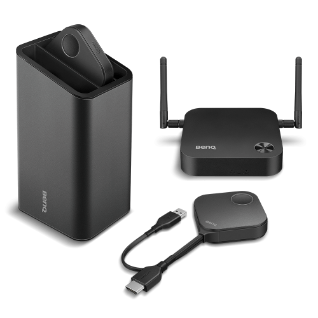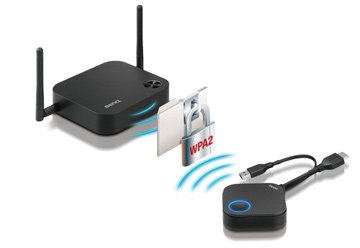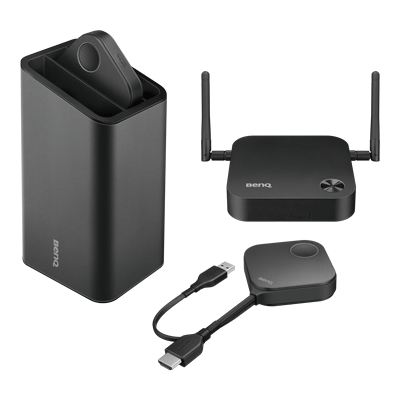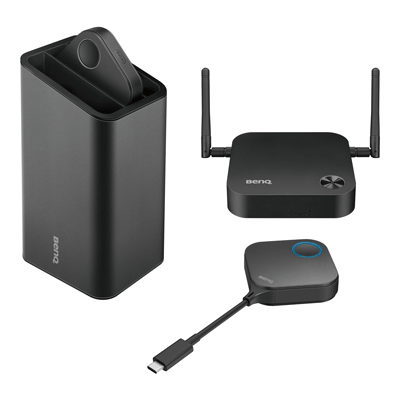The 3 Critical Reasons InstaShow Lets You Present Instantly While Keeping Your Data Secure
- BenQ
- 2019-05-31
As a C-Suite level executive, you no longer face the question of whether to embrace trends such as digitalization and BYOD (Bring Your Own Device), but rather which kinds of technology solutions you need to effectively implement in order to yield benefits from them. Your employees - most of whom are probably part of the “connected generation” - expect the tools provided by upper management to enable them to optimize their personal performance and enhance collaboration with team members. Therefore, the importance of a wireless presentation system - which allows users in a corporate setting to instantly present to a display without cumbersome cabling or projector delays - factors in easily to any decision. Industry data supports the trend, with the dedicated wireless presentation market growing 35% YoY in 2017 to reach 411K units and revenues of over $400 million.1 But bringing in any new solution that connects to your network always raises concerns over security. Data on your highly confidential innovations might be comprised, which can lead to huge financial losses as well as leakages of private customer information.

All the benefits of wireless presentation, minus the risks
Leveraging BenQ’s decades of experience and R&D know-how in both wired and wireless display technologies, InstaShow™ allows you to fully enjoy the business benefits of a wireless presentation system without the security risks posed by using devices with a USB data connection, such as hacks, malware infections, and the reverse engineering of your products. Ensuring the protection of data streamed through InstaShow was one of the major design criteria from the earliest stages of development, a criterion that the system designers and engineers at BenQ spent three years perfecting.* This article will take you through the basics of wireless security and how InstaShow protects your data on every level, including software, data encryption, and network security.
What makes up InstaShow that keeps your data secure?
BenQ's InstaShow™ is a unique, no-software wireless presentation solution that allows multiple presenters to lead from any device. It is composed of a host device and a minimum two buttons, each of which features a USB cable and an HDMI cable**.

● Host: The core of the system and the receiver, the Host can establish wireless connections with 16/32 Buttons concurrently.
● Button: After being clicked, the Button compresses HDMI streaming signals as video and audio codes, which are then sent to the display device connected to Host side instantly via Wi-Fi.
A. A fully hardware-based solution means no malware risk
Because USB Type-A was the most universal interface at the time in terms of compatibility with operating systems, most wireless presentation solutions on the market were designed from a software base. The trade-off of a software-based solution is vulnerability to malware, which may infect your device and even your network.
InstaShow avoids the malware risk of a wireless presentation system in the simplest way imaginable - it is a fully hardware-based, non-USB mass storage solution that transmits data entirely on HDMI video signals for which software support or additional software installation is not required, preventing malicious attacks or threats.*
With InstaShow, the USB connector only serves as a power source and has no data pins, with pure HDMI signal projection used to transfer the visual and audio data only, meaning that it is impossible for the USB connection to be compromised. HDMI
Also, InstaShow provides integrated hardware encoding and decoding, further protecting you against any risk of allowing malware onto your corporate devices.
How InstaShow keeps your data safe: a fully hardware-based, HDMI solution with no additional drivers required means instant device compatibility without malware risk.
B. HDCP as an extra layer of encryption
Besides ensuring enterprise-class data protection via AES 128, WPA2, InstaShow also supports an extra encryption method - HDCP. HDCP (High-bandwidth Digital Content Protection) is a protocol defined by HDMI Association that is used to encrypt the video source and decrypt the video receiver.
InstaShow’s HDCP security handshake - the protocol used to exchange all the information required by both sides for the exchange of the actual application data - allows your company’s presenters to share confidential information without the concern for security breaches during the presentation.

How InstaShow keeps your data safe: an extra layer of data encryption allows for information sharing while making security breaches highly unlikely.
C. No external network access keeps away threats
One of the most deadly challenges for IT staff is opening network ports in your computer and company network. A single attack can be extremely costly, with small- and medium-sized industries losing approximately $120,000 dollars per incident.2 If you are using a wireless presentation solution that connects to a network and requires the opening of network ports, you are already exposing your data to risk during transmission. Where other brands use a wireless router to connect the device to display or allow users to connect their personal mobile devices, InstaShow is a wholly peer-to-peer product. This means the wireless transmitting device is connected directly to the wireless receiving device without any detoured connection, so there is no way to break into the middle of a data transaction.
How InstaShow keeps your data safe: It’s a totally peer to peer product with no connection to the Internet, makes hacking InstaShow next to impossible.
Conclusion
A wireless presentation solution can build employee and stakeholder confidence in your brand, but only if it can ensure protection of your company’s data and the data of your visitors. As a fully hardware-based solution that only transmits visual data over HDMI, InstaShow is easily the most secure product on the market. Add onto that an extra layer of data encryption and no external network access, and you can integrate InstaShow into your company infrastructure without losing a minute of sleep over security concerns.
*Video signals such as HDMI follow standards that are only updated every ten years or so and remain backward compatible with earlier standards, removing concerns about device compatibility.
**It is for InstaShow™ WDC10 and InstaShow™ S WDC20
1. Wireless Presentation Solutions Global Market Report, February 2018, FutureSource
2. What is the Cost of a Data Breach?, Kaspersky Lab Daily
https://www.kaspersky.com/blog/economics-report-2018/22486/

